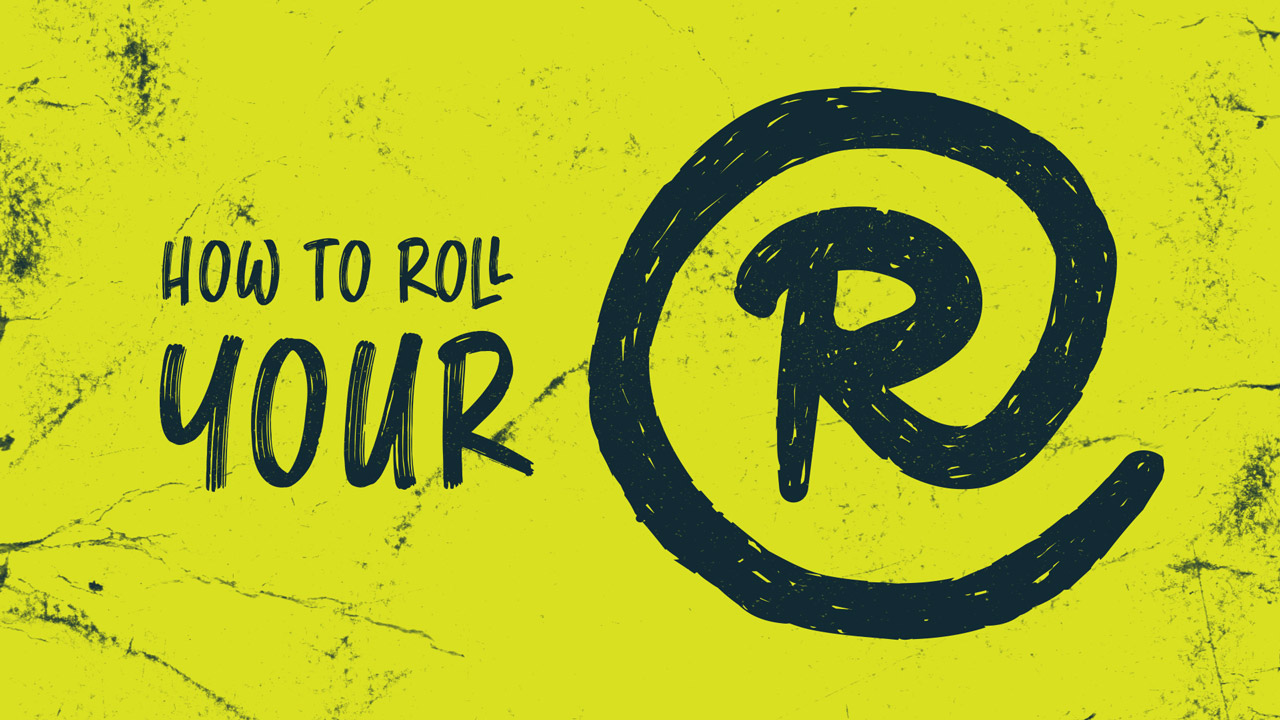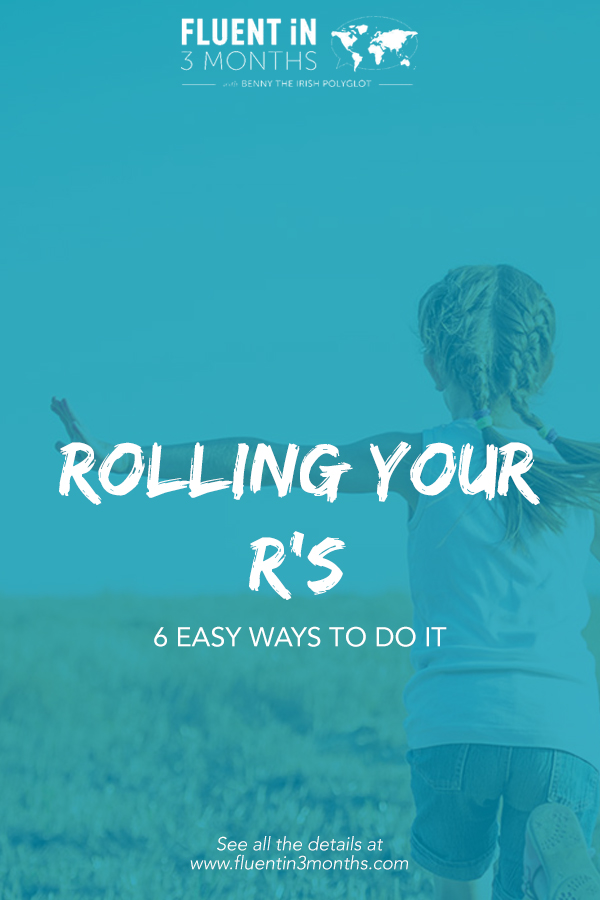5 Easy Ways to Roll Your ‘R’
The rolled r comes up in so many languages. I’ve heard it in various forms in Czech, Thai, Hungarian, Tagalog and of course in Spanish, Italian and Portuguese. And yet learning how to roll your r’s can seem near impossible to native English speakers.
Some people give up and use the excuse of ‘you can’t teach an old dog new tricks’. Others will rely on the English ‘r’ as being good enough, which in my opinion is the worst thing you can do.
I have become fluent in over 8 languages in my adult life, and I have worked hard on my Spanish accents. But what strikes me immediately when I start any language (even in my first attempt to utter a phrase) is how natives are so amazed at how I’ve got almost ‘no English accent’!
While there are many factors at play here, I know that the biggest one by far is that I have worked to master the rolling ‘r’ to improve my Spanish accent unlike some of my anglophone friends.
The English R is really different, so it gives you away immediately when you use it.
I want to put a stop to this nonsense of English speakers not trying or even saying they can’t. The good news is that it is way easier than you think!
Table of contents
- What is a Rolled ‘R’? Is It Possible to Learn This Skill?
- The Spanish ‘R’, the French ‘R’, the Russian ‘R’… What’s the Difference?
- How to Roll Your R’s Strategy #2: Make Your ‘L’ Sharper
- How to Roll Your R’s Strategy #3: Relax Into It!
- How to Roll Your R’s Strategy #4: Youtube / Google That ‘R’
- How to Roll Your R’s Strategy #5: Observe Others Doing It
- Roll With Your Rolled ‘R’!
Let’s get into it.
What is a Rolled ‘R’? Is It Possible to Learn This Skill?
A rolled ‘r’ is actually called an ‘Alveolar tap’ or ‘Alveolar trill’, and it’s actually used in almost half of all spoken languages in some form.
A rolled ‘r’ is made by causing the tongue to vibrate on the roof of the mouth as air is forced between the tiny gap between the roof and your tongue.
It is not tapping the roof of your mouth as fast as you can!
There’s no real equivalent in English to the rolled ‘r’. That’s what makes it so notoriously hard for native English speakers who are used to the very hard R sound.
Despite this, it is possible to learn this skill. Being able to roll your ‘r’s isn’t a genetic trait like, say, being able to roll your tongue.
No, it just takes practice.
It may help to change how you think about it. The name ‘rolled “r”’ is a bit misleading. You aren’t rolling or tapping your tongue at all – it’s more like the tongue is vibrating and relaxed like a leaf flapping in the wind.
The Spanish ‘R’, the French ‘R’, the Russian ‘R’… What’s the Difference?
In this article, we’re going to be talking about how to do an alveolar trill, as in Spanish words with ‘rr’ like ca rr o and the ‘tapped’ ‘r’ as in caro, not the Russian ‘r’ or the French guttural r. They are different!
Spanish actually has two ways to say ‘r’: a tap and a trill.
The alveolar tap is the easier one to learn. And if you learn the tap, you can learn the trill.
But in other languages, like the Russian ‘r’, it’s almost a post-alveolar trill. (Meaning your tongue taps behind the ridge behind your teeth rather than on the ridge).
Meanwhile, the French and German ‘r’ are both pronounced in the throat, making them a completely different sound.
You’ll notice this across languages that use some form of an ‘r’, so it’s something to be aware of.
Now, onto the strategies to learn how to roll your ‘r’!
How to Roll Your R’s Strategy #1: Use Some ‘Butter’
You may be surprised to hear that you can already produce a rolled ‘r’ sound!
When you say the word ‘butter’ quickly, the ‘tt’ sound is made by flapping your tongue against the roof of your mouth, rather than a normal ‘t’ sound (like tree). USE THIS.
It may not be the exact same as a rolled ‘r’ (depending on the language and dialect you are aiming for), as it’s more of the ‘tap’ I mentioned in Spanish.
But it’s more convincing than the English ‘r’ at the end of the same word is.
Try changing one letter at a time from ‘butter’ until you have your target word (e.g. caro). Use this sound and your work is pretty much done!
How to Roll Your R’s Strategy #2: Make Your ‘L’ Sharper
If you want to sound less like an English speaker, the closest sound that you might have to the rolled ‘r’ is actually the letter ‘L’.
I’d recommend you start with this sound and morph it into a rolled ‘r’. In fact, the ‘L’ sound involves placing the top part of your tongue flat against the roof of your mouth. The rolled ‘r’ sound involves flapping the tip of your tongue there.
The sound difference is obvious, but the transition is easier if you start from one and move to the other, making your ‘L’ sharper.
Until then, actually using ‘L’ might be a good way of practising deprogramming yourself from the English ‘r’. Es muy ca_l_o is better than the English s muy caRo.
It’s obviously not a good permanent solution, but a useful stepping stone.
How to Roll Your R’s Strategy #3: Relax Into It!
Think of what is physically happening for the rolled ‘r’ as I’ve tried to explain above. This can be explained in a physiological way, if you look into the positions of the tongue in your mouth. Visualise where it has to be and what you have to be doing with it.
When it comes to the trilled ‘r’ as in carro, you’ll want your tongue to be positioned right on the edge of the ridge of the roof of your mouth, behind your teeth. Try practicing by saying ‘duh’ – that’s right where your tongue should be.
Next, your tongue needs to be relaxed to do a trill. The tip of your tongue needs to have a tiny gap between the ridge and your tongue, so air can pass through.
Push the air like you’re shushing someone: ‘shhhhhhhhh.’
Once you’ve done that, you should feel a bit of the vibration in your tongue which creates the rolled ‘r’ sound. It takes some playing around with: the airflow, relaxing your tongue, making sure your placement is right.
But a good exercise to prepare is actually lip trills. Such as when you blow air out and your lips make a motor sound, or what they call ‘blowing raspberries’.
Once you do your lip trills, you should also feel some of the vibration in your tongue. That’s what you’re looking for with your trill as well as the air passes over the tip of your tongue.
Remember that your tongue should be like a leaf blowing in the wind and relaxed, not super rigid and trying to tap quickly.
How to Roll Your R’s Strategy #4: Youtube / Google That ‘R’
There are many useful resources online that help explain this sound to you in simple terms.
This wikihow article tries to explain step by step what to physically do with your mouth and recommends transitioning from a ‘d’ rather than an ‘L’ as I’ve suggested.
The same article also outlines several completely different methods to learn to roll (and trill) your R. Try each of these methods and you are bound to find one that works for you!
You may also find doing a Youtube search for ‘rolling R’ or variants to yield some useful results. Having it explained visually as well as audibly can help a lot.
How to Roll Your R’s Strategy #5: Observe Others Doing It
Even if you haven’t mastered your rolled ‘r’ yet, don’t worry too much. Please make mistakes NOW and try to say something – you have plenty of time to tidy it up towards something better, and these mistakes will not be burnt into you forever if you are truly willing to learn.
However, by watching videos and listening to natives produce those sounds you will get a better appreciation for that ‘r’ sound.
Pay attention to how it sounds and then try to emulate it.
The truth is, the more you listen to the sound being made, the easier it will become to try and mimic it.
Another option would be to simply get help from another human being.
The best thing you can do by far is to meet up with a native (or at least over Skype) and ask them for help with this.
Finding native speakers in your target language is easy with platforms like Preply, where you can book tutorials with teachers and tutors from all over the world
Live feedback from language exchanges or a tutor that is relevant to you and particular problems you are having can do so much more than generic explanations ever can. And it leaves no room for you guessing that maybe you’ve got it.
Related learning: Listen to an Italian learner’s experience on the Language Hacking podcast.
Roll With Your Rolled ‘R’!
Even before I got serious about speaking Spanish, one of the first things I did when I moved to Spain was to have a patient Spanish speaking friend sit down with me and explain to me how to roll my ‘r’s.
It was frustrating at first, but then I went away to practise, and came back for more adjustments. But that was it! It really helped me on my road to fluency in Spanish.
Thanks to this friend, I eliminated the strong English accent from my Spanish immediately.
There are of course other aspects of your English accent. But working on them one at a time and especially getting help, will always yield the best results.





Social